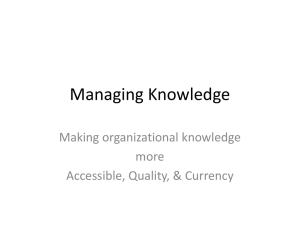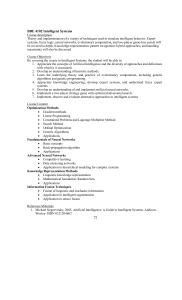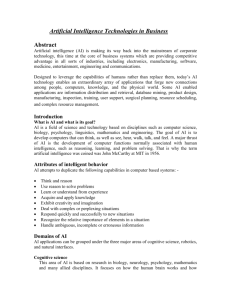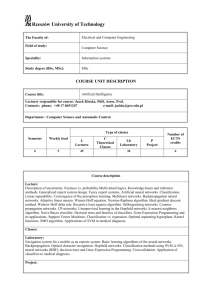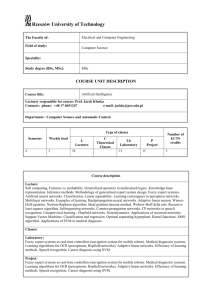Chapter 12: Managing Knowledge in the Digital Firm
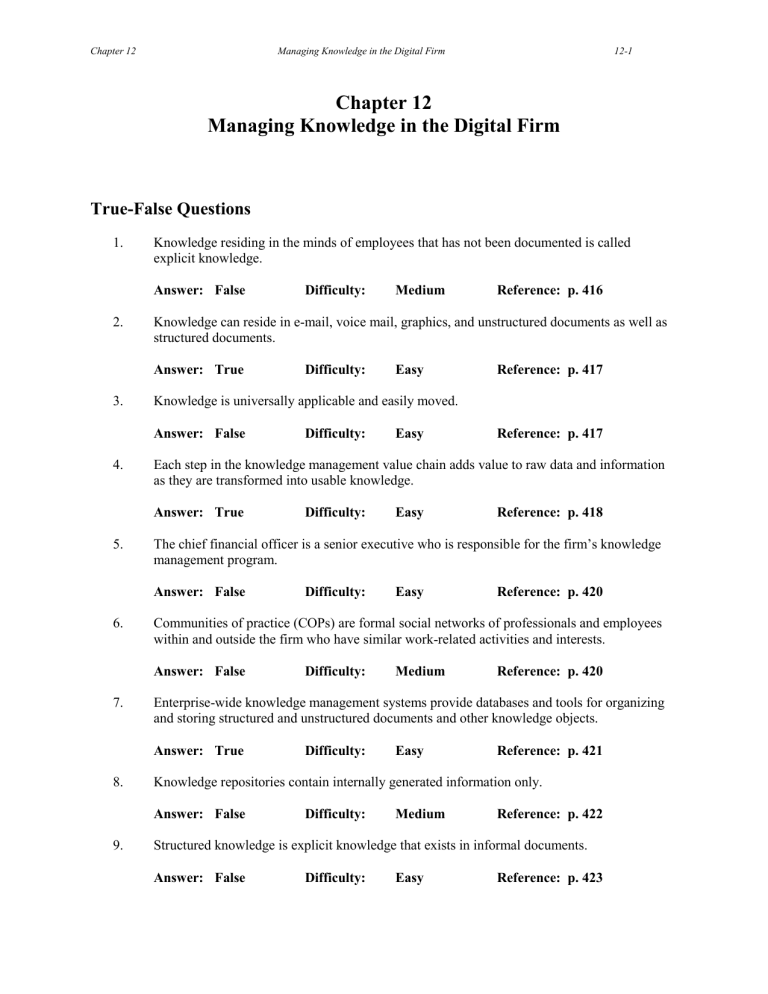
Chapter 12 Managing Knowledge in the Digital Firm 12-1
Chapter 12
Managing Knowledge in the Digital Firm
True-False Questions
1.
Knowledge residing in the minds of employees that has not been documented is called explicit knowledge.
Answer: False Difficulty: Medium Reference: p. 416
2.
Knowledge can reside in e-mail, voice mail, graphics, and unstructured documents as well as structured documents.
Answer: True Difficulty: Easy
3.
Knowledge is universally applicable and easily moved.
Reference: p. 417
Answer: False Difficulty: Easy Reference: p. 417
4.
Each step in the knowledge management value chain adds value to raw data and information as they are transformed into usable knowledge.
Answer: True Difficulty: Easy Reference: p. 418
5.
The chief financial officer is a senior executive who is responsible for the firm’s knowledge management program.
Answer: False Difficulty: Easy Reference: p. 420
6.
Communities of practice (COPs) are formal social networks of professionals and employees within and outside the firm who have similar work-related activities and interests.
Answer: False Difficulty: Medium Reference: p. 420
7.
Enterprise-wide knowledge management systems provide databases and tools for organizing and storing structured and unstructured documents and other knowledge objects.
Answer: True Difficulty: Easy Reference: p. 421
8.
Knowledge repositories contain internally generated information only.
Answer: False Difficulty: Medium Reference: p. 422
9.
Structured knowledge is explicit knowledge that exists in informal documents.
Answer: False Difficulty: Easy Reference: p. 423
12-2 Managing Knowledge in the Digital Firm Chapter 12
10.
Semistructured information is all the digital information in a firm that exists in informal documents.
Answer: False Difficulty: Medium Reference: p. 424
11.
A best practice is a scheme for classifying information and knowledge in such a way that it can be easily accessed.
Answer: False Difficulty: Hard Reference: p. 427
12.
Knowledge network systems seek to turn tacit, unstructured, and undocumented knowledge into explicit knowledge that can be stored in a database.
Answer: True Difficulty: Medium Reference: p. 429
13.
Enterprise knowledge portals can provide access to external sources of information such as news feeds and research.
Answer: True Difficulty: Hard Reference: p. 430
14.
Knowledge workers usually do not possess high levels of education.
Answer: False Difficulty: Easy Reference: p. 431
15.
Knowledge work systems have characteristics that reflect the special needs of knowledge workers.
Answer: True Difficulty: Medium Reference: p. 431
16.
User interfaces are unimportant to the success of knowledge worker systems.
Answer: False Difficulty: Easy Reference: p. 433
17.
Virtual reality systems use interactive graphics software to create computer-generated simulations that are so close to reality that users almost believe they are participating in a real-world situation.
Answer: True Difficulty: Easy Reference: p. 434
18.
VRML is platform dependent, operates over a minicomputer, and requires large amounts of bandwidth.
Answer: False Difficulty: Medium Reference: p. 434
19.
The financial industry is using specialized investment workstations to leverage the knowledge and time of its brokers, traders, and portfolio managers.
Answer: True Difficulty: Medium Reference: p. 435
Chapter 12 Managing Knowledge in the Digital Firm 12-3
20.
Databases and spreadsheets are the primary tools used for knowledge discovery.
Answer: False Difficulty: Easy Reference: p. 435
21.
Genetic algorithms are used for generating solutions to problems that are too large and complex for human beings to analyze on their own.
Difficulty: Medium Reference: p. 435
22.
Intelligent agents can discover underlying patterns, categories, and behaviors in large data sets.
Answer: True
Answer: False Difficulty: Medium Reference: p. 435
23.
Data mining helps organizations capture undiscovered knowledge residing in large databases.
Difficulty: Easy Reference: p. 436
24.
AI applications exhibit the breadth, complexity, originality, and generality of human intelligence.
Answer: True
Answer: False Difficulty: Easy Reference: p. 436
25.
Expert systems capture the knowledge of skilled employees in the form of a set of rules in a software system that can be used by others in the organization.
Answer: True Difficulty: Easy Reference: p. 436
26.
Given their limitations, expert systems are seldom used for making discrete, highly structured decision-making situations.
Answer: False Difficulty: Medium Reference: p. 436
27.
In the IF-THEN construct, a condition is evaluated. If the condition is true, an action is taken.
Answer: True Difficulty: Easy Reference: p. 436
28.
A series of IF-THEN rules can be used to form a knowledge-base.
Answer: True Difficulty: Easy Reference: p. 436
29.
In backward chaining the inference engine begins with the information entered by the user and searches the rule base to arrive at a conclusion.
Answer: False Difficulty: Easy Reference: p. 437
12-4 Managing Knowledge in the Digital Firm Chapter 12
30.
When developing an expert system, team members develop a prototype system to test assumptions.
Answer: True Difficulty: Easy Reference: p. 437
31.
Expert systems work by applying a set of AND-OR rules against a knowledge base, both of which are extracted from human experts.
Answer: False Difficulty: Medium Reference: p. 439
32.
Case-based reasoning cannot be used in diagnostic systems in medicine.
Difficulty: Easy Reference: p. 439
33.
Fuzzy logic can describe a particular phenomenon or process linguistically and then represent that description in a small number of flexible rules.
Answer: False
Answer: True Difficulty: Medium Reference: p. 440
34.
Fuzzy logic can be used to express relationships very generally and compactly, requiring fewer IF-THEN rules than traditional software programs.
Answer: True Difficulty: Medium Reference: p. 442
35.
Neural networks are not particularly suited to finding patterns and relationships in massive amounts of data.
Answer: False Difficulty: Medium Reference: p. 441
36.
Neural networks “learn” patterns from large quantities of data by sifting through data, searching for relationships, building models, and correcting over and over again the model’s own mistakes.
Answer: True Difficulty: Medium Reference: p. 441
37.
Because neural network applications always explain why they arrive at a particular solution, they are well suited for use in the medical profession.
Answer: False Difficulty: Medium Reference: p. 442
38.
Genetic algorithms are conceptually based on the process of evolution.
Answer: True Difficulty: Medium Reference: p. 442
39.
Intelligent agents cannot be programmed for such menial tasks as deleting junk e-mail.
Answer: False Difficulty: Medium Reference: p. 444
Chapter 12 Managing Knowledge in the Digital Firm 12-5
40.
Shopping bots are a form of intelligent agent.
Difficulty: Medium Answer: True
Multiple Choice Questions
Reference: p. 444
41.
The percentage of Gross Domestic Product of the United States that produced by the knowledge and information sectors is estimated to be: a. 20 percent. b. 40 percent. c. 60 percent. d. 80 percent.
Answer: c Difficulty: Medium Reference: p. 416
42.
Expertise and experience of organizational members that has not been formally documented best describes: a. wisdom. b. information. c. data. d. tacit knowledge.
Answer: d Difficulty: Medium Reference: p. 416
43.
Knowledge that resides in the minds of employees that has not been documented is called: a. tacit knowledge. b. organizational memory. c. standard operating procedures. d. corporate culture.
Answer: a Difficulty: Medium Reference: p. 416
44.
The set of business processes, culture, and behavior required to obtain value from investments in information systems is one type of : a. knowledge culture. b. knowledge discovery. c. organizational and management capital. d. organizational routine.
Answer: c Difficulty: Hard Reference: p. 418
12-6 Managing Knowledge in the Digital Firm Chapter 12
45.
The senior executive responsible for the firm’s knowledge management program is the: a. CTO. b. CIO. c. CKO. d. CEO.
Answer: c Difficulty: Easy Reference: p. 420
46.
Informal social networks of professionals and employees within and outside the firm who have similar work-related activities and interests are called: a. communities of practice. b. communities of discovery. c. communities of interest. d. communities of knowledge.
Answer: a Difficulty: Medium Reference: p. 420
47.
Which of the following are major types of knowledge management systems? a. Management information systems, decision support systems, and transaction processing systems. b. Enterprise systems, customer support systems, and supply chain management systems. c. Database management systems, expert systems, and knowledge work systems. d. Enterprise-wide knowledge management systems, knowledge work systems, and intelligent techniques.
Answer: d Difficulty: Hard
48.
Which of the following are types of intelligent techniques?
Reference: p. 420 a. Knowledge networks b. Case based reasoning c. Computer-aided design d. Virtual reality
Answer: b Difficulty: Hard Reference: p. 421
49.
Which of the following would NOT be classified as a knowledge work system? a. Computer-aided design b. 3D Visualization c. Investment workstations d. Case-based reasoning
Answer: d Difficulty: Hard Reference: p. 421
Chapter 12 Managing Knowledge in the Digital Firm 12-7
50.
Which of the following would NOT be classified as a form of intelligent technique? a. Data mining b. Case based reasoning c. Neural networks d. Virtual reality
Answer: d Difficulty: Hard Reference: p. 421
51.
A system for organizing structured knowledge in a repository where it can be accessed throughout the organization best describes: a. database management system. b. expert system. c. structured knowledge system. d. neural network.
Answer: c Difficulty: Medium Reference: p. 422
52.
Key features of an enterprise knowledge network include all of the following EXCEPT: a. knowledge exchange services. b. community of practice support. c. auto-profiling capabilities. d. productivity techniques.
Answer: d Difficulty: Medium Reference: p. 423
53.
One of the largest players specializing in the development of semistructured knowledge systems is a Canadian software company known as: a. Hummingbird. b. Blue bird. c. Purple martin. d. Red robin.
Answer: a Difficulty: Easy
54.
Virtually all expert systems deal with problems of: a. policy development. b. classification. c. logic and control. d. high complexity.
Answer: b Difficulty: Medium
Reference: p. 425
Reference: p. 427
12-8 Managing Knowledge in the Digital Firm Chapter 12
55.
Once a knowledge taxonomy is produced, documents are all __________ with the proper classification. a. tagged b. linked c. tupled d. referenced
Answer: a Difficulty: Medium
56.
A widely adopted enterprise knowledge network system is: a. Hummingbird. b. AskMe. c. Ask Jeeves. d. Tagger.
Reference: p. 427
Answer: b Difficulty: Medium Reference: p. 429
57.
Tools for the management, delivery, tracking, and assessment of various types of employee learning best describes: a. investment workstation. b. organizational learning system. c. employee enrichment system. d. learning management system.
Answer: d Difficulty: Medium Reference: p. 430
58.
Most knowledge workers require specialized knowledge work systems, but they also rely on: a. office systems. b. schools and universities. c. imaging systems. d. data transferring systems.
Answer: a Difficulty: Medium Reference: p. 431
59.
A ________________________ is very important to a knowledge worker’s system. a. careful filing system b. financial analysis system c. dynamic interactive extranet d. user-friendly interface
Answer: d Difficulty: Medium Reference: p. 433
Chapter 12 Managing Knowledge in the Digital Firm 12-9
60.
_______________________________ often are designed and optimized for the specific tasks to be performed. a. Graphics programs b. Knowledge workstations c. Virtual simulators d. CAD stations
Reference: p. 433 Answer: b Difficulty: Medium
61.
Virtual reality applications for the Web use a standard called: a. CADDIS. b. VRML. c. KWSVR. d. TCP/IP.
Answer: b Difficulty: Medium Reference: p. 434
62.
Investment workstations: a. provide engineers, designers, and factory managers with precise control over industrial design and manufacturing. b. provide an important source of expertise for organizations. c. allow groups to work together on documents. d. are high-end PCs used in the financial sector to analyze trading situations instantaneously and facilitate portfolio management.
Answer: d
63.
Virtual reality systems:
Difficulty: Easy Reference: p. 435 a. provide engineers, designers, and factory managers with precise control over industrial design and manufacturing. b. provide an important source of expertise for organizations. c. allow groups to work together on documents. d. provide drug designers, architects, engineers, and medical workers with precise, photorealistic simulations of objects.
Answer: d Difficulty: Medium Reference: p. 435
12-10 Managing Knowledge in the Digital Firm Chapter 12
64.
CAD/CAM workstations: a. provide engineers, designers, and factory managers with precise control over industrial design and manufacturing. b. provide an important source of expertise for organizations. c. allow groups to work together on documents. d. are high-end PCs used in the financial sector to analyze trading situations instantaneously and facilitate portfolio management.
Answer: a Difficulty: Medium
65.
Which of the following is used for knowledge discovery? a. Expert systems b. Transaction processing systems c. Case-based reasoning d. Data mining
Reference: p. 435
Answer: d Difficulty: Medium Reference: p. 436
66.
To automate routine tasks to help firms search for and filter information for use in electronic commerce and supply chain management a firm would most likely use: a. CAD systems. b. Virtual reality systems. c. Fuzzy logic systems. d. Intelligent agents.
Answer: d
67.
Expert systems:
Difficulty: Medium a. solve problems too difficult for human experts. b. are based on DO WHILE rules. c. work in very limited domains.
Reference: p. 436 d. share characteristics with mainframe computing.
Answer: c Difficulty: Medium Reference: p. 436
68.
It is unlikely you could represent the knowledge in the Encyclopedia Britannica with an expert system because: a. there is no one expert who understands all the material contained within the encyclopedia. b. the knowledge changes radically over a short time. c. not all the knowledge in the encyclopedia can be represented in the form of IF-THEN rules. d. the knowledge is too general.
Answer: c Difficulty: Easy Reference: p. 436
Chapter 12 Managing Knowledge in the Digital Firm 12-11
69.
The AI shell is: a. a strategy for searching the rule base in an expert system that begins with information entered by the user. b. the programming environment of an expert system. c. a method of organizing expert system knowledge into chunks. d. a strategy for searching the rule base in an expert system that begins with a hypothesis.
Answer: b
70.
An inference engine is:
Difficulty: Medium Reference: p. 436 a. a strategy for searching the rule base in an expert system that begins with information entered by the user. b. the programming environment of an expert system. c. a method of organizing expert system knowledge into chunks. d. a strategy used to search through the rule base in an expert system in one of two ways.
Answer: d
71.
Forward chaining is:
Difficulty: Medium Reference: p. 436 a. a strategy for searching the rule base in an expert system that begins with information entered by the user. b. the programming environment of an expert system. c. a method of organizing expert system knowledge into chunks. d. a strategy for searching the rule base in an expert system that begins with a hypothesis.
Answer: a
72.
Backward chaining is:
Difficulty: Medium Reference: p. 436 a. a strategy for searching the rule base in an expert system that begins with information entered by the user. b. the programming environment of an expert system. c. a method of organizing expert system knowledge into chunks. d. a strategy for searching the rule base in an expert system that begins with a hypothesis.
Answer: d Difficulty: Medium Reference: p. 437
12-12 Managing Knowledge in the Digital Firm Chapter 12
73.
Before an expert system is integrated into the data flow and work patterns of the organization, it is: a. checked against a similar working system. b. made comprehensible to the operations personnel. c. patented or copyrighted. d. tested by a range of experts within the organization against performance criteria established earlier.
Answer: d Difficulty: Medium Reference: p. 438
74.
Which of the following is the expert system used by Countrywide Funding Corp. to make preliminary creditworthiness decisions on loan requests? a. AskMe b. EVAL c. CLUES d. CBR
Answer: c Difficulty: Medium
75.
Expert systems are expensive and time-consuming to maintain:
Reference: p. 438 a. because their rule base is so complex. b. because they rely on equipment that becomes outdated. c. because their rules must be reprogrammed every time there is a change in the environment, which in turn may change the applicable rules d. because only the person who created the system knows exactly how it works, and may not be available when changes are needed.
Answer: c Difficulty: Medium Reference: p. 439
76.
Ford Motor Company developed an application that backs a simulated tractor trailer into a parking space. The system was developed using: a. case-based reasoning. b. artificial intelligence. c. fuzzy logic. d. expert system.
Answer: c Difficulty: Medium Reference: p. 440
Chapter 12 Managing Knowledge in the Digital Firm 12-13
77.
Systems whose architecture is based on the human brain’s mesh-like neuron structure are called: a. knowledge-based systems. b. neural networks. c. fuzzy logic systems. d. expert system.
Answer: b Difficulty: Medium Reference: p. 441
78.
Hardware and software that attempts to emulate the processing patterns of the biological brain best describes: a. neural network. b. expert system. c. case-based reasoning. d. fuzzy logic.
Answer: a
79.
Genetic algorithms:
Difficulty: Medium Reference: p. 441 a. develop solutions to particular problems using fitness, crossover, and mutation. b. represent knowledge as groups of characteristics. c. do not work for most problems. d. are based on logic.
Answer: a Difficulty: Medium
80.
Which of the following are not used to capture tactic knowledge?
Reference: p. 442 a. expert systems b. case-based reasoning c. fuzzy logic d. Intelligent agents
Answer: d Difficulty: Medium Reference: p. 444
Fill In the Blanks
81.
Data is defined as the flow of events or transactions captured by an organization’s system that, by itself, is useful for transacting, but little else.
Difficulty: Easy Reference: p. 416
12-14 Managing Knowledge in the Digital Firm Chapter 12
82.
To turn data into useful information , a firm must expend resources to organize data into categories of understanding.
Difficulty: Easy Reference: p. 416
83.
Knowledge is the concepts experience, and insight that provide a framework for creating, evaluating, and using information.
Reference: p. 416
84.
To transform information into knowledge , a firm must expend additional resources to discover patterns, rules, and contexts where the knowledge works.
Difficulty: Easy
Reference: p. 416
85.
Wisdom is thought to be the collective and individual experience of applying knowledge to the solution of problems.
Difficulty: Easy
Difficulty: Easy Reference: p. 416
86.
Tacit knowledge is the expertise and experience of organizational members that has not been formally documented.
Difficulty: Easy Reference: p. 416
87.
Knowledge residing in the minds of employees that has not been documented is called tacit knowledge .
Difficulty: Easy Reference: p. 416
88.
Knowledge residing in the minds of employees that has been documented is called explicit knowledge.
Difficulty: Easy Reference: p. 416
89.
Changing organizational behavior by sensing and responding to new experience and knowledge is called organizational learning .
Difficulty: Easy Reference: p. 418
90.
Knowledge management refers to the set of business processes developed in an organization to create, store, transfer, and apply knowledge.
Difficulty: Easy Reference: p. 418
91.
Document management systems digitize, index, and tag documents according to a coherent framework.
Difficulty: Easy Reference: p. 419
Chapter 12 Managing Knowledge in the Digital Firm 12-15
92.
The chief knowledge officer (CKO) is a senior executive who is responsible for the firm’s knowledge management system.
Difficulty: Easy Reference: p. 420
93.
Communities of practice (COPs) are informal social networks of professionals and employees within and outside the firm who have similar work-related activities and interests.
Difficulty: Medium Reference: p. 420
94.
Knowledge work systems (KWS) are specialized systems built for engineers, scientists, and other knowledge workers charged with discovering and creating new knowledge for a company.
Difficulty: Medium Reference: p. 421
95.
Knowledge management also includes a diverse group of intelligent techniques, such as data mining, expert systems, neural networks, fuzzy logic, genetic algorithms, and intelligent agents.
Difficulty: Easy Reference: p. 421
96.
Knowledge that already exists inside a firm in the form of structured text documents and reports or presentations is referred to as structured knowledge .
Difficulty: Easy Reference: p. 422
97.
Knowledge that exists inside a firm in the form of voice mail, e-mail, chat room exchanges, videos, digital pictures, brochures, or bulletin boards is commonly referred to as semistructured knowledge.
Difficulty: Easy Reference: p. 422
98.
A knowledge repository is a collection of internal and external knowledge in a single location for more efficient management and utilization by the organization.
Difficulty: Medium Reference: p. 422
99.
Knowledge network systems are also known as expertise location and management systems .
100.
Difficulty: Medium Reference: p. 423
Structured knowledge is explicit knowledge that exists in formal documents, as well as in formal rules that organizations derive by observing experts and their decision-making behaviors.
Difficulty: Easy Reference: p. 423
12-16 Managing Knowledge in the Digital Firm Chapter 12
101.
102.
103.
104.
105.
106.
107.
108.
109.
110.
A taxonomy is a scheme for classifying information and knowledge in such a way that it can be easily accessed.
Difficulty: Medium Reference: p. 427
A learning management system (LMS) provides tools for the management, delivery, tracking, and assessment of various types of employee learning and training.
Difficulty: Medium Reference: p. 430
Knowledge workers include researchers, designers, architects, scientists, and engineers who primarily create knowledge and information for the organization.
Difficulty: Easy Reference: p. 431
Computer aided design (CAD) automates the creation and revision of designs, using computers and sophisticated graphics software.
Difficulty: Easy Reference: p. 433
Virtual reality systems have visualization, rendering, and simulation capabilities that go far beyond those of conventional CAD systems.
Difficulty: Easy Reference: p. 434
Virtual Reality Modeling Language (VRML) is a set of specifications for interactive, threedimensional modeling on the World Wide Web that can organize multiple media types, including animation, images, and audio to put users in a simulated real-world environment.
Difficulty: Easy Reference: p. 434
Artificial intelligence (AI) technology consists of computer-based systems that attempt to emulate human behavior.
Difficulty: Easy Reference: p. 436
Expert systems are an intelligent technique for capturing tacit knowledge as a set of rules in a very specific and limited domain of human expertise.
Difficulty: Easy Reference: p. 436
The model of human knowledge used by expert systems is called the knowledge base .
Difficulty: Easy Reference:
The AI shell is the programming environment of an expert system.
Difficulty: Easy Reference: p. 436 p. 436
Chapter 12 Managing Knowledge in the Digital Firm 12-17
111.
112.
113.
114.
115.
116.
117.
118.
119.
The strategy used to search through the rule base is called the inference engine .
Difficulty: Easy Reference: p. 436
In forward chaining the inference engine begins with the information entered by the user and searches the rule base to arrive at a conclusion.
Difficulty: Hard Reference: p. 436
In backward chaining the strategy for searching the rule base starts with a hypothesis and proceeds by asking the user questions about selected facts until the hypothesis is either conformed or disproved.
Difficulty: Medium Reference: p. 437
A(n) knowledge engineer is similar to a traditional systems analysts but has special expertise in eliciting information and expertise from other professionals.
Difficulty: Easy Reference: p. 437
In case-based reasoning (CBR) , descriptions of past experiences of human specialists, represented as cases are stored in a database for later retrieval when the user encounters a new case with similar parameters.
Difficulty: Medium Reference: p. 439
Fuzzy logic is a rule-based technology that can represent such imprecision by creating rules that use approximate or subjective values.
Difficulty: Easy Reference: p. 440
Neural networks are used for modeling complex, poorly understood problems for which large amounts of data have been collected.
Difficulty: Easy Reference: p. 441
Genetic algorithms are used for finding the optimal solution for a specific problem by examining a very large number of possible solutions for that problem.
Difficulty: Easy Reference: p. 442
Genetic algorithms, fuzzy logic, neural networks, and expert systems can be integrated in a single application to take advantage of the best features of these technologies. Such systems are called hybrid AI systems .
Difficulty: Medium Reference: p. 443
12-18 Managing Knowledge in the Digital Firm Chapter 12
120.
Intelligent agents are software programs that work in the background without direct human intervention to carry out specific, repetitive, and predictable tasks for individual user, business process, or software applications.
Difficulty: Easy Reference: p. 444
Essay Questions
121.
122.
123.
What is knowledge management? Briefly outline the knowledge management chain.
Knowledge management is the set of processes developed in an organization to create, gather, store, disseminate, and apply the firm’s knowledge. The five steps in the knowledge management chain include acquisition, storage, dissemination, application, and management and organizational activities.
Identify the three major types of knowledge management systems. Provide two examples of each.
The major types of knowledge management systems are enterprise knowledge management systems, knowledge work systems, and intelligent techniques. Structured knowledge systems and knowledge networks are types of enterprise knowledge management systems. Computer- aided design and virtual reality are two types of knowledge work systems. Data mining and neural networks are types of intelligent techniques. Figure 12-3 in the textbook provides additional examples.
Identify three types of knowledge. What type of enterprise knowledge management system is needed to support each type?
Structured, semistructured, and network are three types of knowledge. Structured knowledge is found in the form of structured documents and reports. A structured knowledge system can be used for organizing such knowledge in a repository. Semistructured knowledge is information in the form of less structured objects and can benefit from a semistructured knowledge system. The semistructured knowledge system organizes and stores less structured information, including e-mail, voice mail, videos, and graphics. Network knowledge includes the expertise of individuals and can be supported by knowledge networks. A knowledge network is an online directory for locating corporate experts in well-defined knowledge domains.
Chapter 12 Managing Knowledge in the Digital Firm 12-19
124.
125.
126.
127.
Why are knowledge workers so important to the digital firm? Which of the functions they perform do you feel is most critical to the success of the firm? Why?
Knowledge workers create new products or find ways to improve existing ones. Without them, the firm would stagnate and become less competitive in an environment that is always changing and is increasingly more competitive. In the modern economy, knowledge is truly power. The three major functions of knowledge workers are: keeping the organization up-todate in knowledge as it develops in the external world, serving as internal consultants regarding their areas of knowledge and its opportunities, and acting as change agents as they evaluate, initiate, and promote new projects.
Identify three specific requirements of knowledge work systems.
Knowledge work systems must give knowledge workers the specialized tools they need, such as powerful graphics, analytical tools, and communications and document-management tools.
Knowledge work systems must provide a user-friendly interface to the KWS. These userfriendly interfaces save time by allowing the user to perform needed tasks and get to required information without having to spend a lot of time learning to use the computer.
Knowledge work systems must be carefully designed to optimize the performance of the specific tasks of the pertinent knowledge worker.
Discuss the concept of virtual reality, especially with regard to VRML and its applications in the business arena.
Virtual reality systems use interactive graphics software and hardware to create the illusion of reality in cyberspace. The original applications were in gaming, but new uses in education, science, and business are being developed and have great promise. Virtual reality applications are being developed for the Web using a standard called Virtual Reality Modeling Language
(VRML), which can organize multiple media types to put users in a simulated real-world environment. VRML is platform independent, operates over a desktop computer, and requires little bandwidth. DuPont’s HyperPlant is an example of a business application. HyperPlant allows users to go through three-dimensional models as if they were physically walking through a plant, which reduces errors during the construction of manufacturing structures.
How might a company go about building an expert system?
An AI development team is chosen, composed of one or more experts, who have a thorough command of the knowledge base, and one or more knowledge engineers, who can translate the knowledge described by the expert into a set of rules or frames. The team members select a problem appropriate for the expert system. The project will balance potential savings from the proposed system against the cost. The team members develop a prototype system to test assumptions. Next, they develop the full-scale system, focusing mainly on the addition of a very large number of rules. The complexity of the system grows with the number of rules, so comprehensibility may be threatened. The system is then edited and pruned to achieve simplicity, elegance, and power. The system is tested against the performance criteria established earlier. Once tested and accepted, the system is then integrated into the data flow and work patterns of the organization.
12-20 Managing Knowledge in the Digital Firm Chapter 12
128.
Differentiate between each of the following pairs of words: neural networks and expert systems, fuzzy logic and genetic algorithms, hybrid AI systems and intelligent agents.
A neural network attempts to emulate the processing patterns of the biological brain. It results in a program that can “learn” by comparing solutions to known problems to sets of data presented to it. An expert system works by a system of IF-THEN rules against a knowledge base. By answering a series of yes/no questions, the program arrives at a “diagnosis” or
“conclusion”.
Fuzzy logic uses nonspecific terms called “membership functions” to solve problems by comparing the ranges into which various specifications fall and reaching a conclusion based on rules covering the various relationships. Genetic algorithms are problem-solving methods that use the model of living organisms adapting to their environment. Possible solutions are evaluated, the “best” choices are made, then more possible solutions are created by combining the factors involved in those first “best” choices, and choosing again. The process continues until an optimum solution is reached.
Hybrid AI systems use multiple AI technologies in a single application, taking advantage of the best features of each. This is a new field, and has great promise for business applications.
Intelligent agents are software programs that use a built-in or a learned knowledge base to carry out specific, repetitive, and predictable tasks for a user, business process, or software application.
129.
130.
they be addressed?
Knowledge management systems are difficult to implement successfully and they do not always provide value after they are put in place. It can be difficult to prove quantitative benefits for knowledge management systems and identify ways of genuinely increasing knowledge worker productivity. Firms can provide appropriate organizational and management capital to make these systems successful by rewarding knowledge sharing, promoting communities of practice and a knowledge culture, and designing appropriate taxonomies for organizing knowledge. Proper planning, development of appropriate measurements of benefits, and staged rollout can increase the chances of success for knowledge management projects. Key management decisions include identifying business processes for which knowledge management systems can provide the most value.
How do experts systems work?
Expert systems capture tacit knowledge from a limited domain of human expertise and express that knowledge in the form of rules. The strategy to search through the knowledge base, called the inference engine, can use either forward or backward chaining. Expert systems are most useful for problems of classification or diagnosis. Case-based reasoning represents organizations knowledge as a database of cases that can be continually expanded and refined. When the user encounters a new case, the system searches for similar cases, finds the closest fit, and applies the solutions of the old case to the new case. The new case is stored with successful solutions in the case database.
